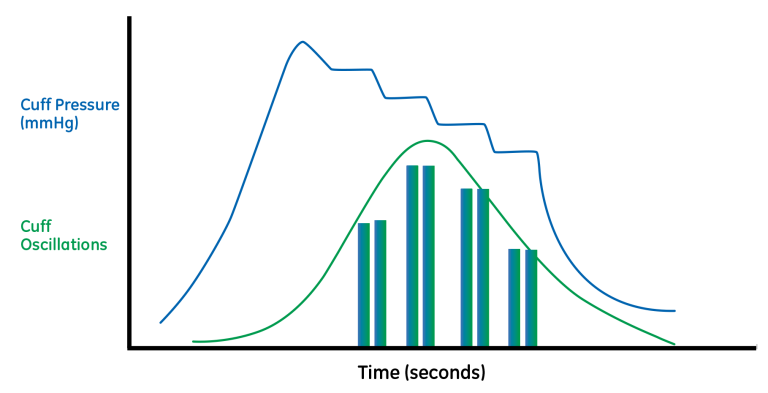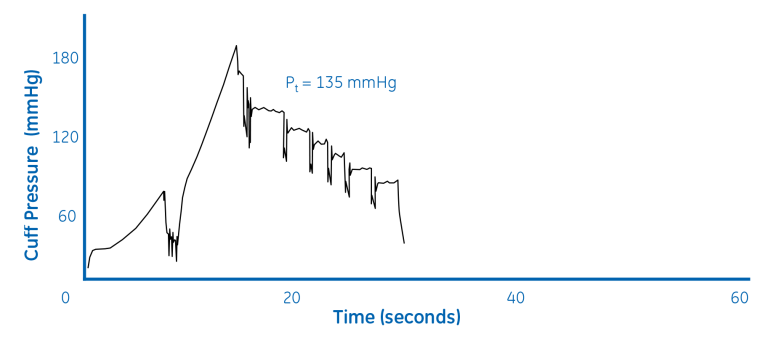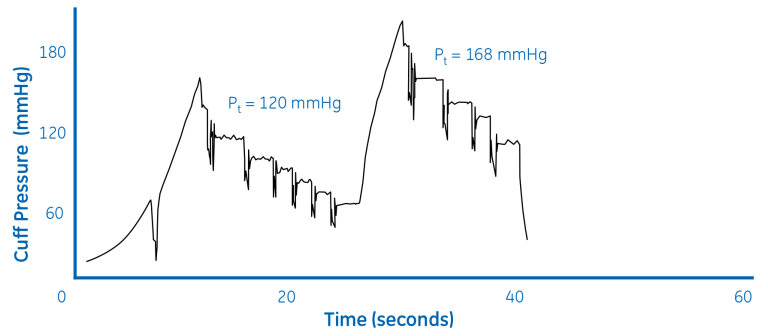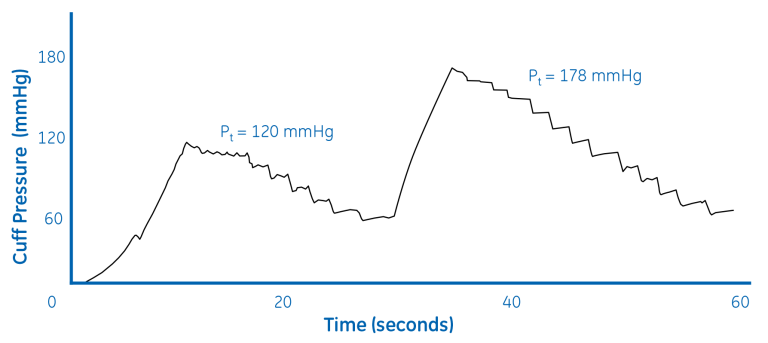Setting target inflation pressure
Bruce Friedman, D.Eng.
Introduction
The DINAMAP™ SuperSTAT non-invasive blood pressure (NIBP) algorithm in the CARESCAPE™ Patient Data Module, Dash™ and CARESCAPE V100 monitors incorporates patented curve fitting1 and cuff pressure managment2,3 technologies which enable the use of lower target inflation pressures. Setting a lower target inflation pressure improves patient comfort and safety, can reduce determination times and improves overall NIBP performance.
An additional feature of the CARESCAPE Patient Data Module with the DINAMAP SuperSTAT NIBP algorithm is the ability to work at lower signal levels while still maintaining accuracy. This is accomplished through the use of various measures of signal quality, which are used to reduce the impact of noise.4,5,6
Target inflation pressure
The factory default target inflation pressures currently programmed into the Solar™ 8000m/i monitor with V5.0D software are for use with the CARESCAPE Patient Data Module containing the DINAMAP SuperSTAT algorithm:
- Adult cuff pressure: 135 mmHg
- Pediatric cuff pressure: 125 mmHg
- Neonatal cuff pressure: 100 mmHg
These factory default target pressures are also in the CARESCAPE V100 and Dash monitors with the DINAMAP SuperSTAT algorithm.
As described in this whitepaper, there are advantages to lowering the target pressure from the current defaults.
One feature of the DINAMAP SuperSTAT algorithm is the ability to obtain an NIBP determination when the target pressure (Pt) is equal to, or even slightly below, the patient’s systolic pressure (PSYS). As shown in Figure 1a, this is accomplished through the use of the curve fit algorithm in the GE DINAMAP SuperSTAT that enables the extrapolation of systolic pressure of up to approximately 10 mmHg beyond the target pressure.

Figure 1b shows a recording of an NIBP determination made with a computerized data collection system. The target pressure was set to 135 mmHg and the DINAMAP SuperSTAT algorithm correctly obtained the patient’s blood pressure (145/89).

In cases where the target pressure is more than 10 mmHg below the patient’s systolic pressure, the ability of the DINAMAP SuperSTAT algorithm to manage cuff pressure allows it to search at higher cuff pressures to obtain the patient’s blood pressure without significantly increasing determination time.
In Figure 2, the target pressure is set to 120 mmHg, which is significantly below the systolic pressure. After five deflation steps, the algorithm repumps to a higher pressure (Pr). By combining the data from the initial inflation and the repump, the DINAMAP SuperSTAT algorithm is able to obtain the determination in slightly over 40 seconds.

This behavior can be contrasted with the earlier Classic algorithm, as shown in Figure 3. With Pt = 120 mmHg, the Classic algorithm requires more deflation steps before starting a repump. In addition, the repump pressure is higher (178 mmHg) and the algorithm completes a full determination sequence before obtaining the blood pressure (141/82) in 60 seconds. Unlike the DINAMAP SuperSTAT algorithm, the Classic algorithm does not use the data from the initial inflation sequence. The Classic algorithm in the Tram™ module also requires a higher target inflation pressure (160 mmHg).

Changing default target inflation pressures
The default target inflation pressures for adult, pediatric and neonatal cuff types in the Solar monitor can be accessed from the host MAIN MENU by selecting MORE MENUS > MONITOR SETUP > MONITOR DEFAULTS > SETUP DEFAULT DISPLAY and scrolling down the list of defaults. This will reset the default target pressure for all subsequent admissions. For more complete information, please refer to the Solar monitor’s operators manual.
The target inflation pressure for an individual patient can be changed upon admission by selecting INITIAL INFLATION PRESSURE from the NIBP menu. This opens a popup window, which allows selection of target pressure in 5 mmHg increments. For adult and pediatric cuff sizes, the range of pressures is 100 mmHg to 250 mmHg. The cuff will be inflated to the value indicated by the INITIAL INFLATION PRESSURE softkey only when a previous systolic value is not known or could not be obtained. (See Adaptive Inflate.) Upon admission of a new patient, the target pressure will revert to the default.
Higher defaults used with acquisition products containing the Classic algorithm should not be carried forward when upgrading host software for use with products containing the DINAMAP SuperSTAT algorithm.
For changing target inflation pressures in the Dash or CARESCAPE V100 monitors, refer to the appropriate operators manual.
Adaptive inflate
In AUTO MODE, the target inflation pressure is determined from the previous systolic value. In the DINAMAP SuperSTAT algorithm, the adaptive inflate is 10 mmHg above the previous systolic value. This allows the CARESCAPE Patient Data Module to adjust the inflation pressure as the patient’s condition changes. If the patient’s blood pressure changes rapidly, for example, a hypertensive patient whose blood pressure drops suddenly after intubation, returning to the set target pressure can improve performance. This can be accomplished by selecting CLEAR NBP READING from the NBP menu.
Summary
The GE DINAMAP SuperSTAT algorithm is designed to work at lower target inflation pressures. In hospital units that frequently see hypotensive patients (systolic < 100 mmHg), NIBP performance can be optimized by reducing the Adult default target from 135 mmHg to 110 mmHg when using the CARESCAPE Patient Data Module or Dash monitor. The final selection of target inflation pressure should be done with reference to the clinical characteristics of the patients in each hospital unit.
Higher target pressures, while appropriate for hypertensive patients, can result in prolonged determination times and determination timeouts in hypotensive patients.
References
- Hersh L.T., Friedman B. and Medero R., “Method for oscillometric blood pressure determination employing curve fitting,” U.S. patent 5, 704, 362
- Medero R., “Oscillometric blood pressure monitor with enhanced cuff pressure control,” U.S. patent 5, 579, 776
- Kolluri S., Hersh L.T. and Medero R., “Physiological-signal-analysis device for measuring a blood pressure and method,” U.S. patent 6, 746, 403
- Medero R., Hersh L.T., Kolluri S. and Friedman R., “Artifact rejection using pulse quality values,” U.S. patent 7, 070, 566
- Friedman B., Hersh L.T. and Medero R., “Calculation of quality and its use in determination of indirect noninvasive blood pressure,” U.S. patent 6, 358, 213
- Kolluri S., Hersh L.T. and Medero R., “Oscillometric determination of blood pressure,” U.S. patent 6, 893, 403








